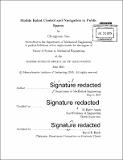| dc.contributor.advisor | H. Harry Asada. | en_US |
| dc.contributor.author | Yan, Chengyuan | en_US |
| dc.contributor.other | Massachusetts Institute of Technology. Department of Mechanical Engineering. | en_US |
| dc.date.accessioned | 2015-12-16T16:33:22Z | |
| dc.date.available | 2015-12-16T16:33:22Z | |
| dc.date.copyright | 2015 | en_US |
| dc.date.issued | 2015 | en_US |
| dc.identifier.uri | http://hdl.handle.net/1721.1/100345 | |
| dc.description | Thesis: S.M., Massachusetts Institute of Technology, Department of Mechanical Engineering, 2015. | en_US |
| dc.description | Cataloged from PDF version of thesis. | en_US |
| dc.description | Includes bibliographical references (pages 71-73). | en_US |
| dc.description.abstract | Public service robots have been more and more popular due to their social and economical influences. This thesis investigated two issues about control and navigation of public service robots deployed in crowded environments such as airports and shopping malls. Our solutions facilitates the synergy of a distributed sensor network and a central computer. A distributed sensor network provides multi-view measurements without occlusion, and a central computer can use these data to estimate the state of everything in the environment in real-time. A public service robot should have human-like mobility, but a wheeled robot is vulnerable to fall when it transits to escalators/moving walkways that are commonly seen in public places. A compliant coupler is inserted between the wheel and the drive motor, which could block instantaneous impacts during the transition. A feedback control is designed to improve the transmission system's damping and regulate the robot's ground speed. A simulated robot was able to transit between ground and moving walkways smoothly using the series elastic transmission and unified velocity control. To help a public service robot reach its destination efficiently without causing much annoyance to nearby humans, we developed a three-layer hierarchical path planner. Every layer plans at a different temporal and spatial scale, and the plans are refined as they are passed from top level to the bottom level. The intermediate level planner bridges global path optimality and local path optimality, and is discussed in detail. Using a fluid analogy, the medium planner treats individual passengers as fluid particles, and tries to find a path so that the total pressure received is minimized. Navigation maps are introduced as an augmentation to navigation functions, which indicate the shortest path towards goal to a robot. Using a finite-horizon optimization, the medium planner can react to the dynamic crowd promptly. Simulations show that the planner is able to plan appropriate paths in many different scenarios. | en_US |
| dc.description.statementofresponsibility | by Chengyuan Yan. | en_US |
| dc.format.extent | 73 pages | en_US |
| dc.language.iso | eng | en_US |
| dc.publisher | Massachusetts Institute of Technology | en_US |
| dc.rights | M.I.T. theses are protected by copyright. They may be viewed from this source for any purpose, but reproduction or distribution in any format is prohibited without written permission. See provided URL for inquiries about permission. | en_US |
| dc.rights.uri | http://dspace.mit.edu/handle/1721.1/7582 | en_US |
| dc.subject | Mechanical Engineering. | en_US |
| dc.title | Mobile robot control and navigation in public spaces | en_US |
| dc.type | Thesis | en_US |
| dc.description.degree | S.M. | en_US |
| dc.contributor.department | Massachusetts Institute of Technology. Department of Mechanical Engineering | |
| dc.identifier.oclc | 931070142 | en_US |
